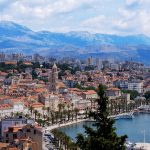The story of winemaking in Korčula is an ancient tale, dating back to the Greeks, but these days it can be summarized into two major winegrowing regions, and three most significant wine varieties grown on the island.
Total Croatia Wine has written about all three of those varieties, and we’ll just briefly recap to help you navigate all that wonderful wine available on this island. There is a wine festival called “Black Island – White Wines”, and that title will give you a hint what types of wines those three varieties are.
Grk is a white wine variety grown almost exclusively on Korčula, specifically on the sandy and very dry soils around the village of Lumbarda at the easternmost tip of the island. The strip of land between two coastlines is very narrow there, so the grapes get a lot of sunlight and reflection off the sea, resulting in very high sugars along with excellent acids. Although the word “grk” literally means bitter, the wine is usually dry, high in acidity, somewhat aromatic and fruity with hints of pine and saltiness. Recent genetic studies have not shown any connection with the Greek varieties, rather it is confirmed to be indigenous to Croatia and a close relative to Zinfandel. And that is not the only direct link between the white grape of Grk and the indigenous red Plavac Mali: the other one is that Grk grape only has female flowers, so it’s unable to produce the fruit without the secondary variety growing alongside it in the vineyard. And that secondary variety is usually Plavac Mali in the Lumbarda vineyards, and has been for centuries, because both of those varieties blossom at the same time. Not a lot of Grk is produced and bottled yearly (after all, there are less than 40 acres of Grk vineyards on Korčula!), so don’t miss the opportunity to take a nice tour of the wineries in the Lumbarda Field. The last name you’ll see the most is Cebalo, as three members of the family are producing Grk, Bartul, Branimir and Zoran. Other notable producers are Milina-Bire and Milina-Lovrić families, as well and Zure family (http://www.total-croatia-wine.com/croatian-wine-producers/958-croatian-winemakers-ivan-and-marko-batistic-zure-our-new-vineyard-is-a-rebellion-against-karst).
Moving away from Lumbarda and closer to the geometric centre of the island, in the sheltered fields there lay the wine-producing regions of Čara and Smokvica, and two varieties ruling there are Pošip and Rukatac. The name “Pošip” either comes from a local word that describes the specific shape of the berry, or because the original vines were grown next to and around the pomegranate tree (šipak), which grows abundantly in the area. It is proven that Pošip is indigenous to the island of Korčula. The grapes are picked relatively early, and are unusually sweet for such an early variety, with adequate acids. One of the things wine-lovers almost never do is eat the grapes fresh, off the vine, but with pošip – if you ever get the chance, go for it, it’s delicious to eat! The wine is golden yellow in colour, very viscous in the glass, dry, it has relatively high alcohol content (sometimes over 14 percent) and the aroma is very fruity, reminiscent of apricots, citrus fruits, almonds and figs. Unlike Grk, Pošip has been spreading throughout Dalmatia, so it’s possible to find great Pošip from Pelješac, Hvar, Makarska and Skradin, but you should definitely try the original, Korčula-grown Pošip. The biggest producer is PZ Pošip Čara, and there are several smaller, family-sized producers in Smokvica-Čara area whose wines are really worth tasting (Intrada-Krajančić, Šain-Marelić, Kunjas, Toreta, Radovanović).
The other major white wine variety in the central part of Korčula Island is Rukatac. It’s a variety of many names: it is so abundant and so easy to cultivate that it can be found throughout the Mediterranean, including most of the Croatian coast and it’s called Maraština mostly elsewhere (on Pelješac, Konavle, Lastovo, Mljet and around Zadar), and on Korčula the name you would use is Rukatac. The grapes ripen rather late, consistently give rather high yields, and the sugar content is high when grown on the best possible locations – that should be expected at the positions where it’s grown today, where it gets quite a lot of sun. It has traditionally been used to complement other wine varieties, but when made into wine on its own, it makes a typical southern white wine. Sometimes it’s called “a female wine”, because it’s fragrant and fruity (apricot-y and peach-y), golden yellow colour, full-bodied with hints of vanilla, quite low alcohol content and low acids (that is the reason why it’s so often blended with other varieties that have higher acids). Rukatac is one of the best Croatian wine varieties for making dessert straw wine using passito method (in Croatian it is called prošek; not to be mistaken with Italian prosecco), and most prošek wine made in the south has Rukatac in it. On Korčula, make sure you taste Rukatac produced by PZ Čara, Toreta and Milina wineries on Korčula.
You will be able to find a lot of Plavac Mali wine on the island as well, as many producers grow and bottle it. While Plavac Mali from Korčula can get really good, it will probably never be as spectacularly good as the best of Dingač or Postup from Pelješac, and the quality is mostly consistent among producers. So, don’t shy away from the red wine on the island!







